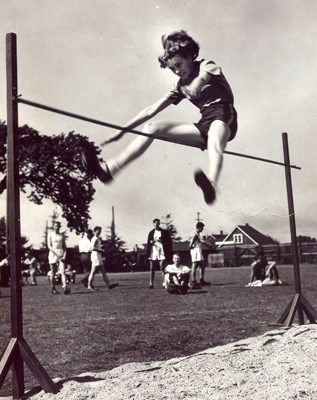As opportunities for athletes with a disability continue to improve, the story of Vancouvers Shirley Olafsson, one of B.C.s oldest living Olympians, is particularly relevant. Olafsson was an athlete with a disability at a time when competitions such as the Paralympics did not exist. She competed in the high jump against able-bodied athletes, one of the first to do so at the Olympic Games in 1948.
"If I'd had two good legs, I could have been a great jumper, but I made do," the 84-year-old Olafsson said this month, overlooking the fact that, by any standard, she was a great jumper. Pleased that more opportunities and a stronger support system are in place for Paralympic athletes today, she nonetheless coolly assesses current privileges and financing that she did without.
"We didn't have helpers and training and money that the athletes get today," she said. "We had none of it, but somehow we got by."
Born Shirley Gordon in Vancouver, Olafsson had what doctors called a turned foot. She lacked a left heel bone. From age two to four, she wore a cast and later underwent several operations, effectively locking her foot in place and stunting its growth. She spent much time at the fledgling Children's Hospital.
In high school, she wore an embarrassing brace and two sizes of shoes: five-and-a-half on one foot, nine-and-a-half on the other. Some called her a cripple. None of it helped the shy teen's self confidence, yet never deterred her either. Olafsson had an incredibly strong will.
"All my life I've struggled. Even now I struggle. Anything I do, all the time. Nothing's changed because my foot is frozen the same as when I was young. It doesn't move," she said.
Walking was a challenge; wearing heels impossible. Standing for long periods taxed her frail leg. Despite great pain and discomfort, Olafsson experimented with different sports in high school. A mean-spirited field hockey coach suggested she'd make a better goal-post than a player. She enjoyed basketball, but often found herself on the bench, although she was on the roster for the 1944-45 Â鶹´«Ã½Ó³»Hedlunds squad that won the Canadian title, a 1989 B.C. Sports Hall of Fame team inductee.
Olafsson's good friend at King Edward high, Millie Cheater, a future Canadian Olympic sprinter, convinced her to try track and field. Testing every event to see what she could manage with her foot, Olafsson settled on the high jump, an odd choice considering the stress placed on the feet. She adopted her own unorthodox take on the scissor technique by both taking off and landing on her strong right foot. It also meant she jumped an extra three inches to clear the bar.
"Every time I decided to try something new I would say to myself, 'Well, I think I can do this. I'll just have to work at it a little harder than everyone else.'"
Olafsson practised alone every day after school while patients at a hospital across the street watched from their windows. When she made a height successfully, they clapped for her. The modest encouragement helped.
Despite the obstacles, Olafsson proved she had a gift for high jump. At the 1948 Canadian championships in Montreal, she leapt a personal best five feet, 2.5 inches to finish second and earn a surprise spot on the Canadian Olympic track and field team. She'd sail to London, the first Games in 12 years because of the Second World War. In post-war London, athlete lodgings were basic and food was poor. Over 70,000 people watched the women's high jump at Wembley Stadium. Olafsson tied for 10th with a personal best of 1.5 metres.
Two years later, she won the 1950 national championship and represented Canada at the 1950 British Empire Games in Auckland. She finished fifth.
She retired in 1952.
Olafsson, now a resident of Richmond, worked for the Â鶹´«Ã½Ó³»park board and coached elementary students, something she's done continuously since the age of 17. Recognition for Olafsson's athletic success includes induction into the B.C. Sports Hall of Fame as an individual pioneer athlete in 2004. In 2008, she was one of 10 Canadians chosen to run in Beijings Olympic torch relay. In 2010, she ran along Richmond's No. 1 Road carrying Vancouver's Olympic torch.
Her participation in both relays was secured by Joy Fera, a 1976 Canadian Olympic rower who lobbied on her behalf. In mock seriousness, Olafsson now calls Fera her booking agent.
Fera is currently working on booking one more engagement for Olafsson: a return to London in 2012 to complete her hat trick of Olympic torch relays, 64 years after her first visit to the city as a very determined high jumper.
Jason Beck is the curator of the B.C. Sports Hall of Fame and Museum.



